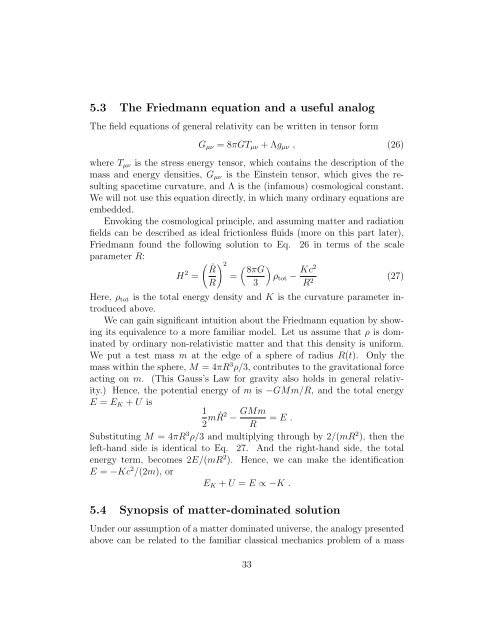Lecture Notes for Astronomy 321, W 2004 1 Stellar Energy ...
Lecture Notes for Astronomy 321, W 2004 1 Stellar Energy ...
Lecture Notes for Astronomy 321, W 2004 1 Stellar Energy ...
Create successful ePaper yourself
Turn your PDF publications into a flip-book with our unique Google optimized e-Paper software.
5.3 The Friedmann equation and a useful analog<br />
The field equations of general relativity can be written in tensor <strong>for</strong>m<br />
G µν = 8πGT µν + Λg µν , (26)<br />
where T µν is the stress energy tensor, which contains the description of the<br />
mass and energy densities, G µν is the Einstein tensor, which gives the resulting<br />
spacetime curvature, and Λ is the (infamous) cosmological constant.<br />
We will not use this equation directly, in which many ordinary equations are<br />
embedded.<br />
Envoking the cosmological principle, and assuming matter and radiation<br />
fields can be described as ideal frictionless fluids (more on this part later),<br />
Friedmann found the following solution to Eq. 26 in terms of the scale<br />
parameter R:<br />
(Ṙ ) 2 ( ) 8πG<br />
H 2 = = ρ tot − Kc2<br />
(27)<br />
R 3 R 2<br />
Here, ρ tot is the total energy density and K is the curvature parameter introduced<br />
above.<br />
We can gain significant intuition about the Friedmann equation by showing<br />
its equivalence to a more familiar model. Let us assume that ρ is dominated<br />
by ordinary non-relativistic matter and that this density is uni<strong>for</strong>m.<br />
We put a test mass m at the edge of a sphere of radius R(t). Only the<br />
mass within the sphere, M = 4πR 3 ρ/3, contributes to the gravitational <strong>for</strong>ce<br />
acting on m. (This Gauss’s Law <strong>for</strong> gravity also holds in general relativity.)<br />
Hence, the potential energy of m is −GMm/R, and the total energy<br />
E = E K + U is<br />
1<br />
2 mṘ2 − GMm<br />
R = E .<br />
Substituting M = 4πR 3 ρ/3 and multiplying through by 2/(mR 2 ), then the<br />
left-hand side is identical to Eq. 27. And the right-hand side, the total<br />
energy term, becomes 2E/(mR 2 ). Hence, we can make the identification<br />
E = −Kc 2 /(2m), or<br />
E K + U = E ∝ −K .<br />
5.4 Synopsis of matter-dominated solution<br />
Under our assumption of a matter dominated universe, the analogy presented<br />
above can be related to the familiar classical mechanics problem of a mass<br />
33













